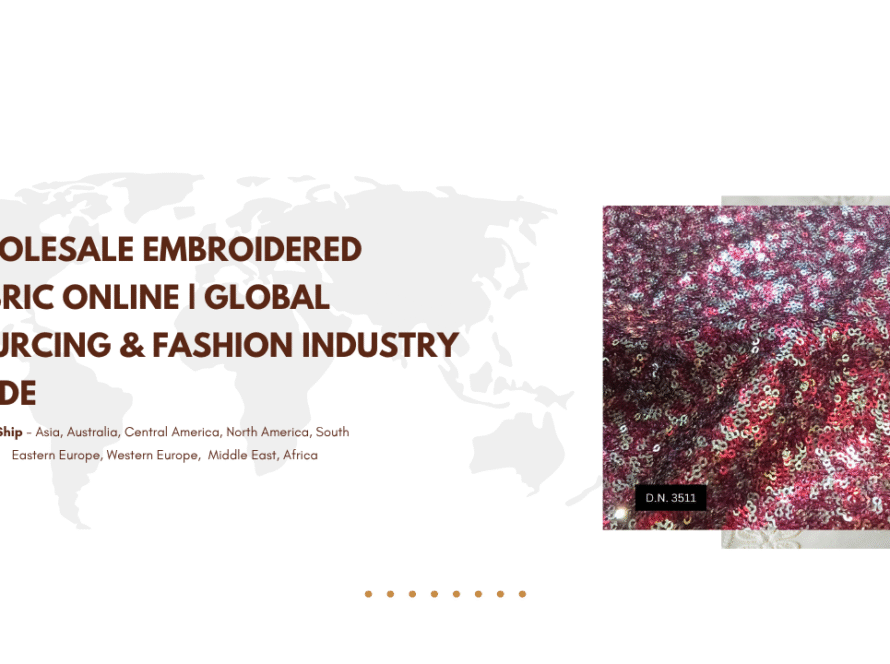Digital print fabric is a modern textile printing technology that uses digital methods to create intricate designs on various types of fabric.
Unlike traditional printing methods, which often involve screens or stencils, digital printing directly applies ink to the fabric using inkjet technology.
Digital Print Fabric Manufacturers in Asia: Types, Benefits, and Trends
This process allows for greater design flexibility, vibrant colors, and faster production times.
Types of Digital Print Fabric
Digital print fabric can be classified into several categories based on the type of fabric used and the printing technique. Here are some of the most common types:
- Cotton Digital Print Fabric:
- Cotton is one of the most popular fabrics for digital printing due to its natural fibers, softness, and breathability. This fabric is often used for clothing, home textiles, and accessories.
- Polyester Digital Print Fabric:
- Polyester is a synthetic fabric that holds color well and is durable. Digital prints on polyester are vibrant and long-lasting, making them ideal for sportswear and outdoor gear.
- Silk Digital Print Fabric:
- Silk provides a luxurious feel and has a natural sheen that enhances printed designs. Digital printing on silk is often used for high-end fashion garments and accessories.
- Satin Digital Print Fabric:
- Satin is known for its glossy surface and smooth texture. Digital prints on satin are often used in evening wear, lingerie, and luxury home décor items.
- Canvas Digital Print Fabric:
- Canvas is a heavy-duty fabric often used for bags, upholstery, and art prints. Digital printing on canvas allows for detailed designs and is popular among artists and interior designers.
- Linen Digital Print Fabric:
- Linen is a natural fiber known for its breathability and texture. Digital printing on linen is used for summer clothing, table linens, and curtains.

Advantages of Digital Print Fabric
- Design Versatility: Digital printing allows for complex and unique designs that can be easily modified or customized for specific projects.
- Shorter Lead Times: The digital printing process requires less setup time than traditional methods, allowing manufacturers to produce smaller runs and react quickly to market trends.
- Eco-Friendly Options: Many digital printers use water-based inks and sustainable fabrics, reducing the environmental impact of the printing process.
- Cost-Effective for Small Runs: Digital printing is ideal for small production runs, making it accessible for independent designers and small businesses.

Digital Print Fabric Manufacturers in Asia
Asia is home to numerous digital print fabric manufacturers known for their innovative techniques and high-quality products. Some of the notable manufacturers include:
Madhav Fashion (India)
- Madhav Fashion specializes in high-quality digital print fabrics, offering a wide range of materials and designs. Known for its commitment to innovation and sustainability, Madhav Fashion uses advanced digital printing technologies to create vibrant and intricate patterns, making it a preferred choice among designers in the fashion industry.
Bengaluru Fabrics (India)
- Specializing in a wide range of digital printed fabrics, Bengaluru Fabrics is known for its eco-friendly practices and quick turnaround times.
Liaoning Runte Textile Co., Ltd. (China)
- This manufacturer focuses on producing vibrant digital prints on various materials, including polyester and cotton, catering to fashion and home décor markets.
Mitra Textile (Bangladesh)
- Mitra Textile combines traditional craftsmanship with modern digital printing technology, offering a diverse range of printed fabrics for apparel and home textiles.
Textiles Intelligence (Thailand)
- With a commitment to sustainability, Textiles Intelligence utilizes eco-friendly inks and fabrics, producing high-quality digital prints for various applications.
Sustainable Fabrics (Vietnam)
- This manufacturer emphasizes the use of organic materials and sustainable practices, offering digital print fabrics that appeal to eco-conscious designers and consumers.
Digital print fabric represents a significant advancement in textile printing technology, offering a range of benefits for manufacturers, designers, and consumers. With the ability to produce intricate designs on various materials, digital printing is transforming the fashion and home textile industries. As Asia continues to lead in textile manufacturing, the demand for high-quality digital print fabrics is expected to grow, paving the way for innovative designs and sustainable practices in the future.
___________________________________________
What is digital print fabric, and how does it differ from traditional printing methods?
Digital print fabric refers to textiles that are printed using digital inkjet technology. This method contrasts sharply with traditional printing techniques, such as screen printing or rotary printing, which rely on stencils or screens to transfer ink onto fabric. In digital printing, designs are created and modified using graphic design software, allowing for complex patterns and high-resolution images.
One of the main advantages of digital printing is its ability to produce intricate designs with vibrant colors and gradients. It also allows for on-demand printing, meaning manufacturers can produce small runs without incurring high setup costs, making it ideal for bespoke or customized products. Additionally, digital printing is generally more eco-friendly, as it often uses water-based inks and generates less waste compared to traditional methods. Overall, digital print fabric opens up new possibilities for designers, enabling them to experiment with colors and patterns without the constraints of traditional techniques.
What types of fabrics can be digitally printed?
Digital printing technology is versatile and can be applied to a wide variety of fabrics. Common types of fabrics that can be digitally printed include:
- Cotton: Known for its softness and breathability, cotton is ideal for apparel and home textiles.
- Polyester: This synthetic fabric holds colors well and is popular for sportswear and outdoor gear due to its durability.
- Silk: Offering a luxurious feel and sheen, silk is often used in high-end fashion and accessories.
- Satin: With its glossy finish, satin is commonly used for evening wear and lingerie.
- Canvas: A sturdy fabric ideal for bags and art prints, canvas can showcase detailed designs effectively.
- Linen: Known for its texture and breathability, linen is popular for summer clothing and table linens.
Each fabric type has unique characteristics, influencing how the printed design appears and performs. This diversity allows designers to choose the most suitable material for their specific applications, enhancing the overall quality and aesthetic of their products.
What are the advantages of using digital print fabric?
Digital print fabric offers numerous advantages that make it an appealing choice for designers and manufacturers:
- Design Flexibility: Digital printing allows for complex and intricate designs that can be easily modified, enabling endless creativity.
- Shorter Production Times: The digital printing process requires less setup time than traditional methods, allowing for quicker turnaround times, especially for small batches.
- Cost-Effective for Small Runs: Digital printing is ideal for short production runs, making it accessible for independent designers who may not want to invest in large quantities.
- High-Quality Output: Digital printing produces sharp, vibrant colors and fine details that may be difficult to achieve with traditional methods.
- Eco-Friendly Options: Many digital printers utilize water-based inks and sustainable fabrics, reducing the environmental impact of the printing process.
- Customization: With digital printing, each piece can be unique, allowing for personalized designs and limited editions that cater to specific customer needs.
Overall, these advantages position digital print fabric as a modern solution for diverse textile applications, from fashion to home décor.
How does the digital printing process work?
The digital printing process involves several steps that work together to create high-quality printed fabrics. Here’s a breakdown of the typical process:
- Design Creation: The process begins with the creation of a digital design using graphic design software. Designers can manipulate colors, patterns, and layouts to achieve their desired outcome.
- Pre-Treatment: Before printing, the fabric may undergo pre-treatment to enhance ink adhesion. This step is crucial, especially for synthetic fabrics, as it ensures the ink adheres properly and improves color vibrancy.
- Printing: The digital design is then printed onto the fabric using inkjet technology. The printer sprays tiny droplets of ink onto the surface, allowing for detailed designs and a wide color range.
- Curing: After printing, the fabric is often cured using heat to set the ink. This step ensures durability and wash resistance.
- Finishing: The final step may include post-treatment processes such as washing, finishing, or cutting the fabric into desired shapes and sizes.
This streamlined process enables designers to create unique, high-quality fabric with remarkable speed and precision, making it suitable for various applications.
What is the cost of digital print fabric?
The cost of digital print fabric can vary significantly based on several factors, including the type of fabric, the complexity of the design, and the quantity ordered. Generally, digital print fabric is more cost-effective for small production runs compared to traditional printing methods, which often require extensive setup costs.
- Fabric Type: Natural fibers like silk or high-quality cotton may be more expensive than synthetic options like polyester. The choice of fabric will greatly influence the final cost.
- Design Complexity: More intricate designs or those requiring multiple colors may incur additional costs due to the time and resources needed for printing.
- Order Quantity: Bulk orders typically reduce the per-yard cost. However, for small runs, the price per yard can be higher, as setup costs are spread across fewer pieces.
- Finishing and Treatments: Additional treatments, such as pre- or post-printing processes, can add to the overall cost.
Ultimately, it’s essential for designers and manufacturers to assess their specific needs, including quantity and fabric choice, to get accurate pricing from suppliers.
How can I care for digital print fabric?
Caring for digital print fabric is essential to maintain its quality and extend its lifespan. Here are some guidelines for proper care:
- Washing: Always check the care label before washing. Most digital print fabrics can be machine-washed in cold water on a gentle cycle. Avoid using bleach, as it can damage the fabric and print.
- Drying: It’s best to air dry digital print fabrics to prevent shrinkage or distortion. If using a dryer, select a low heat setting.
- Ironing: When ironing, use a low heat setting and place a cloth between the iron and the fabric to protect the print. Avoid direct contact with the printed surface to prevent damage.
- Storing: Store digital print fabrics in a cool, dry place away from direct sunlight, as prolonged exposure can fade colors over time.
- Spot Cleaning: For stains, it’s recommended to gently spot clean with a mild detergent rather than soaking the entire fabric.
Who is Madhav Fashion, and what do they offer?
Madhav Fashion is a leading manufacturer of digital print fabrics based in India. They are renowned for their diverse range of high-quality textiles that cater to various applications, from fashion apparel to home décor. Madhav Fashion employs advanced digital printing techniques, allowing them to produce vibrant, intricate designs with exceptional detail.
Their product lineup includes cotton, polyester, silk, and other fabrics, providing options for designers looking for quality and variety. The company is committed to sustainability, utilizing eco-friendly inks and processes that minimize waste and reduce environmental impact. Madhav Fashion also offers customization services, enabling designers to bring their unique visions to life on fabric. With a focus on innovation and quality, Madhav Fashion has become a trusted name in the digital print fabric industry, attracting clients both locally and internationally.






